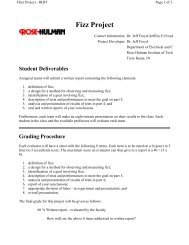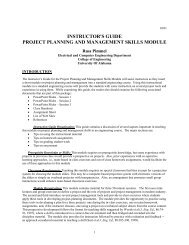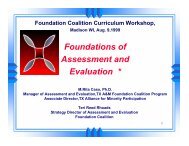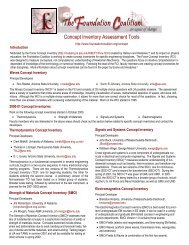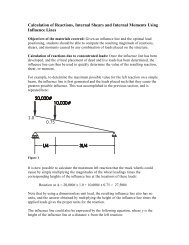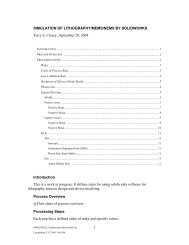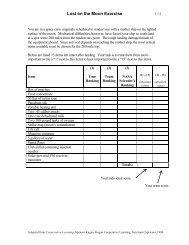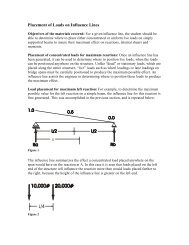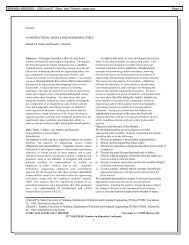Effective Decision Making in Teams - Foundation Coalition
Effective Decision Making in Teams - Foundation Coalition
Effective Decision Making in Teams - Foundation Coalition
You also want an ePaper? Increase the reach of your titles
YUMPU automatically turns print PDFs into web optimized ePapers that Google loves.
Method 6. <strong>Decision</strong> by majority voteProcess: This is the most commonly used method <strong>in</strong> the United States(not synonymous with best method). Discuss the decision until 51% ormore of the team members make the decision.Strengths• Useful when there is<strong>in</strong>sufficient time to makedecision by consensus• Useful when the completeteam-member commitmentis unnecessary forimplement<strong>in</strong>g a decisionWeaknesses• Taken for granted as thenatural, or only, way for teamsto make a decision• Team is viewed as the“w<strong>in</strong>ners and the losers”;reduces the quality of decision• M<strong>in</strong>ority op<strong>in</strong>ion not discussedand may not be valued• May have unresolved andunaddressed conflict• Full group <strong>in</strong>teraction is notobta<strong>in</strong>edAppropriate Times for Method 6• Time constra<strong>in</strong>ts require decision; group consensus support<strong>in</strong>gvot<strong>in</strong>g process; team commitment required to implement decision ismoderately high.What tools are available to assist teams <strong>in</strong> mak<strong>in</strong>gdecisions?In addition to creat<strong>in</strong>g an environment for effective decision mak<strong>in</strong>gand reach<strong>in</strong>g consensus on methods for mak<strong>in</strong>g decisions as a team,there are tools that can assist teams <strong>in</strong> formulat<strong>in</strong>g and reach<strong>in</strong>gdecisions. Many of these tools were developed <strong>in</strong> the 1990s ascompanies worked on improv<strong>in</strong>g quality and <strong>in</strong>troduc<strong>in</strong>g self-managedteams <strong>in</strong>to the workplace. Detailed descriptions of these tools can befound. 6–8 Faculty members and students who would like to becomeproficient <strong>in</strong> the use of these tools are encouraged to consult thesereferences. However, brief descriptions of frequently used tools mayhelp <strong>in</strong>troduce student teams to decision-mak<strong>in</strong>g tools and help themto apply these tools:• Bra<strong>in</strong>storm<strong>in</strong>g (for more <strong>in</strong>formation, please see [6–10])• Aff<strong>in</strong>ity Group<strong>in</strong>g (for more <strong>in</strong>formation, please see [6, 7, 11])• Multivot<strong>in</strong>g (for more <strong>in</strong>formation, please see [6, 7, 12])• Criteria Matrix (for more <strong>in</strong>formation, please see [6, 7, 13])Many other tools are available to facilitate creativity, plann<strong>in</strong>g, andquality control. [14–17]Method 7. <strong>Decision</strong> by consensusProcess: Collective decision arrived at through an effective and faircommunication process (all team members spoke and listened, andall were valued).Strengths• Most effective method ofteam decision mak<strong>in</strong>g• All team members expresstheir thoughts and feel<strong>in</strong>gs• Team members “feelunderstood”• Active listen<strong>in</strong>g used (seecommunication paper)Weaknesses• Takes more time thanmethods 1–6• Takes psychological energyand high degree of teammemberskill (can benegative if <strong>in</strong>dividual teammembers not committed tothe process)Appropriate Times for Method 7• Time available allows a consensus to be reached; the team issufficiently skilled to reach a consensus; the team commitmentrequired to implement the decision is high.Method 7 takes well-practiced communication skills by all teammembers. Review prior section on environments for decision mak<strong>in</strong>gand other m<strong>in</strong>idocuments on effective communication and conflictmanagement.Bra<strong>in</strong>storm<strong>in</strong>gThe goal of the bra<strong>in</strong>storm<strong>in</strong>g process is to generate many optionsrelated to a specific purpose. Subsequent process<strong>in</strong>g will allow thegroup to prioritize and/or group ideas. The focus of the bra<strong>in</strong>storm<strong>in</strong>gprocess is generat<strong>in</strong>g ideas. See [9 10] for details.Keep<strong>in</strong>g the End <strong>in</strong> M<strong>in</strong>dIn work<strong>in</strong>g through a process, visualiz<strong>in</strong>g the end result is helpful. Forthe bra<strong>in</strong>storm<strong>in</strong>g process, the end result is a large set of Post-Itnotes on a flat surface; written on each note is one response to thecharge.Idea 1: VerbnounphraseIdea 3: VerbnounphraseIdea 6: Verb-Noun phraseIdea 7: VerbnounphraseIdea 4: VerbnounphraseIdea 2: VerbnounphraseIdea 8: VerbnounphraseIdea 5: VerbnounphraseMethods for <strong>Decision</strong> Mark<strong>in</strong>g— RetrospectiveThese seven methods/strategies for decision mak<strong>in</strong>g all havestrengths and challenges. However, repeatedly, Method 7 (<strong>Decision</strong>by consensus) has positive long-stand<strong>in</strong>g results regard<strong>in</strong>g teamdecision mak<strong>in</strong>g.Classroom Activity Ask each team to review the sevenmethods for mak<strong>in</strong>g team decisions and construct methods forhow they will make small-scale and large-scale decisions.Ground Rules• Make sure that all participants have a clear, sharedunderstand<strong>in</strong>g of the charge for which they are generat<strong>in</strong>g ideas.• Every idea should be posted, and comments on any idea are notpermitted. Remember that the goal is to generate many ideas atthis stage. Process<strong>in</strong>g ideas will come later.• Strive for flexibility of ideas. Welcome wild ideas that can act astriggers to stimulate breakthroughs <strong>in</strong>to new directions.
Aff<strong>in</strong>ity Group<strong>in</strong>gThe goal of the aff<strong>in</strong>ity group<strong>in</strong>g process is to categorize the ideasgenerated by the bra<strong>in</strong>storm<strong>in</strong>g process. Similar ideas can begrouped together to obta<strong>in</strong> a more organized picture of the ideas.Keep<strong>in</strong>g the End <strong>in</strong> M<strong>in</strong>dIn work<strong>in</strong>g through a process, visualiz<strong>in</strong>g the end result is helpful. Forthe aff<strong>in</strong>ity process, the end result is groups of Post-It notes with aheader card for each group.Header Card:Label for Group1Idea 8: VerbnounphraseIdea 5: VerbnounphraseIdea 2: VerbnounphraseHeader Card:Label for Group2Idea 4: VerbnounphraseIdea 6: VerbnounphraseHeader Card:Label for Group3Idea 1: VerbnounphraseIdea 7: VerbnounphraseIdea 3: VerbnounphraseGround Rules• Decide whether talk<strong>in</strong>g will be allowed as participants group ideanotes <strong>in</strong>to clusters. Results will be different if talk<strong>in</strong>g is allowed.• Participants may take each idea note and put it with another ideanote to form clusters of notes.• Participants may move a note from one cluster to another.• If an idea note is repeatedly moved from one cluster to another,make a duplicate, so that it may be placed <strong>in</strong> both clusters.• After the clusters have stabilized, one member of the group willsolicit suggested word<strong>in</strong>g for a header card. Allow the team toreach consensus on the text for each header card.Multivot<strong>in</strong>gThe goal of the multivot<strong>in</strong>g process is to allow a team to determ<strong>in</strong>e thehigher priority and lower priority options from a set of alternatives.Multivot<strong>in</strong>g is quick and easy. However, it does not provide for adetailed analysis of the different alternative. A team might want to usemultivot<strong>in</strong>g to determ<strong>in</strong>e higher priority options from a large list ofalternatives. Then, the team might use more detailed and timeconsum<strong>in</strong>ganalyses to select the highest priority alternative.Keep<strong>in</strong>g the End <strong>in</strong> M<strong>in</strong>dIn work<strong>in</strong>g through a process, visualiz<strong>in</strong>g the end result is helpful. Forthe multivot<strong>in</strong>g process, the end result is a list of options, each with anumber of votes (perhaps zero). If an option has more votes, then theteam has assigned a higher priority to that option.• Option 1• Option 2• Option 3• Option 4• Option 5With this result, the team has chosen option 2 as the highest priority.Options 4 and 5 have tied for second highest priority. The team maywant to analyze the priority of these three options <strong>in</strong> greater depth.Ground Rules• Assign each participant the same number of votes. A rough rule ofthumb is that each participant may receive a number of votes equalto the number of options divided by three. For concreteness, eachparticipant might vote with sticky dots or small Post-It notes.• Participants vote simultaneously by plac<strong>in</strong>g their sticky dots (ornotes) near or on their preferred options.• In some versions, participants may cast, at most, one vote peroption. In other versions, participants may cast multiple votes peroption, although the maximum number of votes per option may belimited.• Options receiv<strong>in</strong>g more votes are ranked as higher priority.Prioritization MatrixPurposeTo prioritize tasks, issues, alternatives, etc., to aid <strong>in</strong> select<strong>in</strong>g whattasks, issues, or alternatives to pursue.Keep<strong>in</strong>g the End <strong>in</strong> M<strong>in</strong>dThe purpose of the exercise is to construct a matrix like the oneshown on the right. The criteria used to evaluate the quality of theoptions (tasks, issues, alternatives, etc.) are placed across the topwhile the options under consideration are placed down the left. Thenumbers <strong>in</strong> brackets are the weights for the different criteria. Thevalue of the prioritization matrix is twofold. First, it shows the entiregroup the process of evaluat<strong>in</strong>g each option. Second, it focuses thegroup on each component of the decision process and then generatesthe overall results from the <strong>in</strong>dividual decision components.Steps1. Generate a set of criteria to be used <strong>in</strong> evaluat<strong>in</strong>g the quality of thedecision. In the example shown above, the group generated threecriteria.2. Construct a matrix with options down the left and selection criteriaacross the top.Criterion 1 Criterion 2 Criterion 3 Option[2.3] [1.2] [3.5] TotalsOption 1 1 5 3 18.8Option 2 3 2 2 15.3Option 3 2 0 1 8.1Option 4 1 0 1 5.83. Each person allocates a weight (priority) to each criterion. Thehigher the weight, the more important the criterion is to the <strong>in</strong>dividual.The sum of the weights that each person allocates to the criteria mustbe 1.0.4. The total weights for the criteria are obta<strong>in</strong>ed by summ<strong>in</strong>g the<strong>in</strong>dividual weights. Enter these weights <strong>in</strong> the matrix <strong>in</strong> brackets alongwith the criteria.5. Go<strong>in</strong>g one criterion at a time, rank order all the options, etc., withrespect to the criterion us<strong>in</strong>g the multivot<strong>in</strong>g technique. Enter the votetotals for each option <strong>in</strong>to the matrix.6. F<strong>in</strong>d the product of the vote totals and weight for each option andsum these products for each row.7. The rows with the highest sums are the options of highest priority.Be sure to discuss any row which has a low total but seems like itshould be reta<strong>in</strong>ed.
How might I work with students to improve their group decisionmak<strong>in</strong>gskills?Students can improve their decision-mak<strong>in</strong>g skills through awarenessthat decision mak<strong>in</strong>g is not a random act but rather a process<strong>in</strong>volv<strong>in</strong>g effective thought, <strong>in</strong>itiation, communication, and practice.Activities to improve <strong>in</strong>dividual and group decision mak<strong>in</strong>g are sharedbelow.Example 1 (20-25 m<strong>in</strong>utes)Learn<strong>in</strong>g Objective: Students should be able to identify how theytypically make decisions.Classroom Activity Individually ask students to list the sequence ofsteps they use <strong>in</strong> approach<strong>in</strong>g and solv<strong>in</strong>g problems. Next, ask teamsto comb<strong>in</strong>e the <strong>in</strong>dividual problem-solv<strong>in</strong>g sequences <strong>in</strong>to aconsensus problem-solv<strong>in</strong>g sequence. Then, <strong>in</strong>dividually askstudents if they use the problem-solv<strong>in</strong>g sequence with decisionmak<strong>in</strong>g or if decision mak<strong>in</strong>g is more an emotional response for them.Have <strong>in</strong>dividual students identify what changes, if any, they want tomake to their decision mak<strong>in</strong>g methods. Ask teams to share<strong>in</strong>dividual <strong>in</strong>sights from their reflection. F<strong>in</strong>ally, present an openendedproblem (e.g., estimate the number of basketballs that would fit<strong>in</strong> the rooms) or a design problem; ask teams to use their problemsolv<strong>in</strong>gseqence to generate alternative solutions and choose analternative. Compare results across teams <strong>in</strong> the class.Example 2 (15 m<strong>in</strong>utes)Learn<strong>in</strong>g Objective: Increase the likelihood that students will act ontheir proposed changes to their decision-mak<strong>in</strong>g methods.Classroom Activity: Students will create a personal action plan ofwhat changes they want to make to their decision-mak<strong>in</strong>g methodsidentified <strong>in</strong> Example 1. Students put the date and their names onpaper and answer the follow<strong>in</strong>g questions <strong>in</strong>dividually:1. My current decision-mak<strong>in</strong>g method is primarily _____________.2. My decision-mak<strong>in</strong>g method is effective <strong>in</strong> the follow<strong>in</strong>g ways:3. I need to improve/change my decision-mak<strong>in</strong>g skill set <strong>in</strong> thefollow<strong>in</strong>g areas: __________________________.4. My decision-mak<strong>in</strong>g skills improvement goals are as follows (besure your goals are specific, atta<strong>in</strong>able, and measurable):5. These people and these resources can help me accomplish mygoals: _____________________________________________.6. These are my action steps and time table to accomplish my goals:A step <strong>in</strong> which team members share their responses may be added(would take another 20 m<strong>in</strong>utes).Example 3 (45 m<strong>in</strong>utes)Learn<strong>in</strong>g Objective: Students describe how <strong>in</strong>volvement of morepersons <strong>in</strong> the decision-mak<strong>in</strong>g process affects the accuracy of thedecision (adopted from Johnson and Johnson exercise 4 ).Classroom Activity: Expla<strong>in</strong> that the exercise focuses on theaccuracy of estimates made by different comb<strong>in</strong>ations of <strong>in</strong>dividuals.Start with a large jar full of a known quantity of beans set before eachgroup of 4–8 students. Students will be asked to estimate the numberof beans.1. Work<strong>in</strong>g <strong>in</strong>dividually, students need to estimate the number ofbeans and write their answers on pieces of paper.2. Next, pair students. Each pair constructs an estimation scheme,3. Now, each pair jo<strong>in</strong>s another pair and generates an estimate.4. F<strong>in</strong>ally, groups of four partner, and groups of eight constructestimates.5. Have each group of eight present their decision of the number ofbeans. Compare the decisions made to the actual number ofbeans <strong>in</strong> the jar (this is the fun part)6. Now, have the students <strong>in</strong> teams of four answer the follow<strong>in</strong>gquestions: (a) How were the decisions made by each group? (b)How did <strong>in</strong>creas<strong>in</strong>g the number of group members impact thedecision-mak<strong>in</strong>g process for the <strong>in</strong>dividual? (c) How did<strong>in</strong>creas<strong>in</strong>g the number of group members impact the decisionmak<strong>in</strong>gprocess for the group? (d) Did groups become moreefficient or less efficient <strong>in</strong> their decision mak<strong>in</strong>g as group size<strong>in</strong>creased? Do the teams th<strong>in</strong>k there is an “ideal” group size foreffective decision mak<strong>in</strong>g?More activities can be found <strong>in</strong> Johnson and Johnson. 5AcknowledgementMuch of the work with teams across the <strong>Foundation</strong> <strong>Coalition</strong> can betraced to the workshop assembled by Lynn Bellamy and Barry McNeillof Arizona State University. Please see some of their material onteams at http://www.eas.asu.edu/~asufc/team<strong>in</strong>g<strong>in</strong>fo/teams.html.References for further <strong>in</strong>formation1. Katzenbach, J.R., and Smith, D.K., 1992. Wisdom of <strong>Teams</strong>. Boston (HarvardBus<strong>in</strong>ess School Press).2. Johnson, D.W., Johnson, R.T., and Holubec, E.J., 1986. Circles of Learn<strong>in</strong>g:Cooperation <strong>in</strong> the Classroom, rev. ed. Ed<strong>in</strong>a, MN: Interaction Book Co.3. Kl<strong>in</strong>e, N. (1999). Time to th<strong>in</strong>k: Listen<strong>in</strong>g to ignite the human m<strong>in</strong>d. London,England: Ward Lock Well<strong>in</strong>gton House.4. Block, P. (2002). The Answer to How is Yes: Act<strong>in</strong>g on What Really Matters, SanFrancisco: Berrett-Koehler Publishers.5. Johnson, D.W., and Johnson, F.P. (2000). Jo<strong>in</strong><strong>in</strong>g together: Group theory andgroup skills, 7 th ed. Boston: Allyn and Bacon.6. Scholtes, P.R., Jo<strong>in</strong>er, B.L., Streibel, B.J., and Mann, D. (1996). The TeamHandbook, 2d ed., Oriel, Inc.7. Bellamy, L., et al. (1994). Team Tra<strong>in</strong><strong>in</strong>g Workbook, Arizona State University,http://www.eas.asu.edu/~asufc/team<strong>in</strong>g<strong>in</strong>fo/teamwkbk.pdf.8. TQM (Total Quality Management) Toolkit, http://web.mit.edu/tqm/.9. Bra<strong>in</strong>storm<strong>in</strong>g, M<strong>in</strong>dtools,http://www.m<strong>in</strong>dtools.com/pages/article/newCT_04.htm10. Bra<strong>in</strong>storm<strong>in</strong>g.co.uk, http://www.bra<strong>in</strong>storm<strong>in</strong>g.co.uk/11. IS/TQM: Aff<strong>in</strong>ity Diagrams (sometimes referred to as a "KJ", after the <strong>in</strong>itials of theperson who created this technique, Jiro Kawakita),http://web.mit.edu/tqm/aff<strong>in</strong>ity.html.12. Best Practices, Prioritiz<strong>in</strong>g as a Group, Office of Quality Improvement & Office ofHuman Resource Development, University of Wiscons<strong>in</strong> Madison,http://www.ohrd.wisc.edu/meet<strong>in</strong>gs/prioritize.htm#vot<strong>in</strong>g.13. Best Practices, Prioritiz<strong>in</strong>g as a Group, Office of Quality Improvement & Office ofHuman Resource Development, University of Wiscons<strong>in</strong> Madison,http://www.ohrd.wisc.edu/meet<strong>in</strong>gs/prioritize.htm#criteria.14. Shulyak, L., Introduction to TRIZ, http://www.triz.org/downloads/40Ptriz.pdf.15. GOAL/QPC, Seven Creativity Tools,http://www.goalqpc.com/whatweteach/Research/7cr.html.16. GOAL/QPC, Seven Management and Plann<strong>in</strong>g Tools,http://www.goalqpc.com/whatweteach/Research/7mp.html (also found <strong>in</strong>Brassard, M., and Ritter, D. (1994). The Memory Jogger II: A Pocket Guide ofTools for Cont<strong>in</strong>uous Improvement and <strong>Effective</strong> Plann<strong>in</strong>g, Salem, MA: Goal/QPC)17. GOAL/QPC, Seven Quality Control Tools,http://www.goalqpc.com/whatweteach/Research/7qc.html.18. Algert, N.E. (2000). The Center for Change and Conflict Resolution. (979)775-5335, cccr@bigfoot.com.Whether you're just gett<strong>in</strong>g started or look<strong>in</strong>g for additional ideas, the <strong>Foundation</strong> <strong>Coalition</strong> staff would like to help you<strong>in</strong>corporate student teams <strong>in</strong>to your eng<strong>in</strong>eer<strong>in</strong>g classes through workshops, Web sites, lesson plans, and read<strong>in</strong>gmaterials. For suggestions on how to start, see our Web site at or contact Jeffrey Froyd at froyd@ee.tamu.edu or at 979-845-7574.




